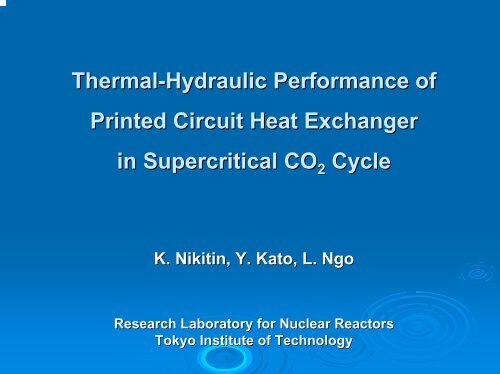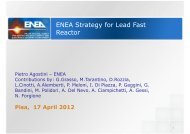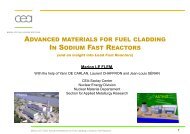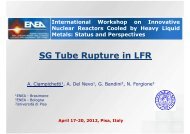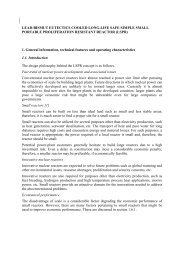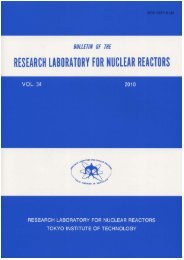Thermal-Hydraulic Performance of Printed Circuit Heat Exchanger in ...
Thermal-Hydraulic Performance of Printed Circuit Heat Exchanger in ...
Thermal-Hydraulic Performance of Printed Circuit Heat Exchanger in ...
Create successful ePaper yourself
Turn your PDF publications into a flip-book with our unique Google optimized e-Paper software.
<strong>Thermal</strong>-<strong>Hydraulic</strong> <strong>Performance</strong> <strong>of</strong><br />
<strong>Pr<strong>in</strong>ted</strong> <strong>Circuit</strong> <strong>Heat</strong> <strong>Exchanger</strong><br />
<strong>in</strong> Supercritical CO 2 Cycle<br />
K. Nikit<strong>in</strong>, Y. Kato, L. Ngo<br />
Research Laboratory for Nuclear Reactors<br />
Tokyo Institute <strong>of</strong> Technology
Study Incentives<br />
o Supercritical CO 2 cycle demonstrates some advantages<br />
<strong>in</strong> comparison to He cycle<br />
- higher cycle efficiency (Y. Kato, 2003),<br />
- better turbomach<strong>in</strong>ery (Y. Muto, 2003),<br />
- power generation cost is expected to be smaller.<br />
o High efficiency recuperator is a crucial component <strong>of</strong><br />
supercritical CO 2 cycle. The targeted recuperator<br />
effectiveness is as high as 95%.<br />
o PCHE is a promis<strong>in</strong>g heat exchanger because it<br />
- is able to withstand the pressure up to 50 MPa and the temperature up<br />
to 700 o C (reliability ),<br />
- has a high compactness and high efficiency (cost reduction).<br />
PCHE = <strong>Pr<strong>in</strong>ted</strong><br />
<strong>Circuit</strong><br />
<strong>Heat</strong><br />
<strong>Exchanger</strong><br />
2005/1/5 Tokyo Institute <strong>of</strong> Technology 2
What is the PCHE?<br />
<br />
<br />
<br />
Fluid flow channels are etched chemically on metal<br />
plates.<br />
- Typical plate: thickness = 1.6mm,<br />
width = 600mm, length = 1200mm,<br />
- Channels have semi-circular pr<strong>of</strong>ile with<br />
1-22 mm diameter.<br />
Etched plates are stacked and diffusion bonded<br />
together to fabricate a block<br />
The blocks are then welded together to form the<br />
complete heat exchanger core<br />
2005/1/5 Tokyo Institute <strong>of</strong> Technology 3
Construction <strong>of</strong> PCHEs<br />
Plate stack<strong>in</strong>g<br />
Diffusion bond<strong>in</strong>g<br />
the bond strength is achieved by<br />
pressure, temperature, time <strong>of</strong> contact,<br />
and cleanl<strong>in</strong>ess <strong>of</strong> the surfaces<br />
2005/1/5 Tokyo Institute <strong>of</strong> Technology 4
Advantages <strong>of</strong> PCHE<br />
Photo-etch<strong>in</strong>g technology:<br />
Micro channels with smaller hydraulic diameter D h :<br />
Pressure capability<br />
PD<br />
<strong>in</strong> excess <strong>of</strong> 50 MPa.<br />
= h<br />
.<br />
Compact size (L)(<br />
) or Higher efficiency (98%).<br />
L =<br />
Dh<br />
4 j<br />
Pr<br />
2/3<br />
No plate-f<strong>in</strong> braz<strong>in</strong>g:<br />
Manufactur<strong>in</strong>g cost reduction.<br />
N<br />
σ<br />
2t<br />
( T<br />
where<br />
o<br />
−Ti<br />
)<br />
N = .<br />
∆T<br />
LMTD<br />
Diffusion bond<strong>in</strong>g technology:<br />
Ma<strong>in</strong>ta<strong>in</strong> parent material strength:<br />
Extreme temperature from cryogenic up to 700 o C.<br />
2005/1/5 Tokyo Institute <strong>of</strong> Technology 5
From HEATRIC homepage<br />
2005/1/5 Tokyo Institute <strong>of</strong> Technology 6
Experimental Facility<br />
Oil Separator<br />
<strong>Heat</strong>er<br />
Cooler<br />
Compressor<br />
PCHE (3kW)<br />
2005/1/5 Tokyo Institute <strong>of</strong> Technology 7
Experimental Loop<br />
Cooler 2<br />
∆P<br />
CO 2 tank<br />
FR<br />
T<br />
PCHE<br />
T,P<br />
T,P<br />
∆P<br />
T<br />
FR<br />
Compressor<br />
Pressure<br />
Reducer<br />
Cooler 1<br />
Oil<br />
Separator<br />
<strong>Heat</strong>er 1 <strong>Heat</strong>er 2<br />
T :thermocouple, P :pressure meter, ∆P :differential pressure meter, FR : flow rate meter<br />
2005/1/5 Tokyo Institute <strong>of</strong> Technology 8
PCHE Test Section<br />
Dimension <strong>of</strong> 896 x 76 x 71 mm and a dry mass <strong>of</strong> 40 kg<br />
Channel geometry (mm) Area, (m 2 )<br />
Channels<br />
number, n<br />
Diameter,<br />
D<br />
Active<br />
length, L<br />
<strong>Hydraulic</strong><br />
diameter, D h<br />
<strong>Heat</strong><br />
transfer, A<br />
Free flow, A c<br />
Hot side 144 1.69 1062<br />
1.03<br />
0.664<br />
64 0.00016<br />
Cold<br />
side<br />
66 1.69 1170<br />
1.03<br />
0.336<br />
36 0.000074<br />
2005/1/5 Tokyo Institute <strong>of</strong> Technology 9
Experimental Conditions<br />
Pressure, MPa<br />
No. 1 2 3 4 5<br />
Cold<br />
side<br />
6.5 7.4 8.5 9.5 10.2<br />
Hot side 2.2 2.5 2.8 3.0 3.3<br />
Temperature,<br />
o<br />
C<br />
Cold<br />
side<br />
90-108<br />
Hot side 280-300<br />
Flow rate, kg/h - From 40 to 80 with 5 kg/h <strong>in</strong>crement<br />
2005/1/5 Tokyo Institute <strong>of</strong> Technology 10
Overall <strong>Heat</strong> Transfer Coefficient, U<br />
‣ LMTD method:<br />
where<br />
U<br />
1 ( Q )<br />
2<br />
c<br />
+ Qh<br />
=<br />
Qc<br />
= Wc<br />
( hc<br />
,<br />
)<br />
( Th,<br />
i<br />
− Tc,<br />
o<br />
) − ( Th,<br />
o<br />
− Tc,<br />
i<br />
)<br />
, o<br />
− hc<br />
i<br />
Ah<br />
FG<br />
ln (<br />
Q = W h − h )<br />
[ T − T ) /( T − T )]<br />
h,<br />
i<br />
c,<br />
o<br />
h,<br />
o<br />
c,<br />
i<br />
h<br />
h( h, o h,<br />
i<br />
1500<br />
A - <strong>Heat</strong> transfer area, 0.664 m 2<br />
C<br />
p<br />
, J/(kg*K)<br />
1400<br />
1300<br />
1200<br />
1100<br />
1000<br />
Hot side<br />
Cold side<br />
P, MPa:<br />
10.2<br />
6.5<br />
3.3<br />
2.2<br />
F G<br />
- Geometric factor, 0.9624<br />
h, c - hot, cold side<br />
o, i - outlet, <strong>in</strong>let<br />
120 160 200 240 280<br />
CO 2<br />
temperature, o C<br />
2005/1/5 Tokyo Institute <strong>of</strong> Technology 11
<strong>Heat</strong> Loss Estimation (1)<br />
Total value:<br />
1) From outer surface temperature <strong>of</strong> PCHE <strong>in</strong>sulator<br />
Q<br />
loss<br />
= ∑<br />
i=<br />
1,10<br />
A<br />
<strong>in</strong>s<br />
i<br />
[<br />
4 4<br />
εσ ( T − T ) + h ( T − T )] ≈ 110 ~ 120 [ ]<br />
s, i surr conv , i s,<br />
i surr<br />
W<br />
2) From heat balance<br />
Q<br />
loss<br />
= Q h<br />
− Q c<br />
<strong>Heat</strong> loss, [W]<br />
150<br />
140<br />
130<br />
120<br />
110<br />
100<br />
From heat balance<br />
Pressure range, [MPa]<br />
6.5-2.2<br />
7.4-2.5<br />
8.5-2.8<br />
9.5-3.0<br />
10.2-3.3<br />
90<br />
40 50 60 70 80 90<br />
Flow rate, [kg/h]<br />
From outer surface temperature<br />
2005/1/5 Tokyo Institute <strong>of</strong> Technology 12
<strong>Heat</strong> Loss Estimation (2)<br />
Effect on the outlet temperatures:<br />
3) From 2D FLUENT CFD calculations (with(2)/without(1) heat loss)<br />
(1) (2)<br />
4) From the heat loss compensation experiments<br />
PCHE<br />
PCHE−surf<br />
Insulator Q ≈ 0<br />
<strong>Heat</strong>ers<br />
T<br />
k<br />
k<br />
= Tnear−heater−surf<br />
loss<br />
∆T<br />
Thot<br />
, out +∆Thot<br />
, out<br />
Tcold<br />
, out +∆Tcold<br />
, out<br />
'<br />
hot, out<br />
: Whot<br />
× ∫ Cp(<br />
P(<br />
T ), T ) dT = −0.35Qloss;<br />
∆Tcold,<br />
out<br />
: Wcold<br />
× ∫ Cp(<br />
P(<br />
T ), T ) dT = −0.<br />
65<br />
T<br />
T<br />
hot , out<br />
2005/1/5 Tokyo Institute <strong>of</strong> Technology 13<br />
cold , out<br />
Q<br />
'<br />
loss
Overall heat transfer coefficient, U<br />
U, [W/m 2 K]<br />
650<br />
600<br />
550<br />
500<br />
450<br />
400<br />
350<br />
300<br />
Pressure, [MPa]<br />
6.5-2.2<br />
7.4-2.5<br />
8.5-2.8<br />
9.5-3.0<br />
10.2-3.3<br />
2.5 3.0 3.5 4.0 4.5 5.0 5.5 6.0<br />
Reynolds number × 10 -3<br />
U =<br />
3<br />
( 18.6 ± 6.8) + (0.105±<br />
0.002) × Re, 2×<br />
10 < Re < 6×<br />
10<br />
3<br />
2005/1/5 Tokyo Institute <strong>of</strong> Technology 14
Pressure factor, f P<br />
0.07<br />
Pressure factor, f P<br />
0.06<br />
0.05<br />
0.04<br />
0.03<br />
hot side<br />
cold side<br />
Pressure range, [MPa]<br />
6.5-2.2<br />
7.4-2.5<br />
8.5-2.8<br />
9.5-3.0<br />
10.2-3.3<br />
0.02<br />
2 4 6 8 10 12<br />
Reynolds number × 10 -3<br />
−6<br />
−8<br />
3<br />
3<br />
f P ,<br />
= ( 0.032±<br />
0.002) −(1.01×<br />
10 ± 6×<br />
10 ) × Re, 2×<br />
10 ≤ Re≤6×<br />
10<br />
hot<br />
−6<br />
−8<br />
3<br />
3<br />
f P ,<br />
= ( 0.066±<br />
0.001) −(1.11×<br />
10 ± 7×<br />
10 ) × Re, 6×<br />
10 ≤ Re≤12×<br />
10<br />
cold<br />
2005/1/5 Tokyo Institute <strong>of</strong> Technology 15
PCHE cross-section<br />
section<br />
2005/1/5 Tokyo Institute <strong>of</strong> Technology 16
Head loss <strong>in</strong> PCHE<br />
∆p<br />
=<br />
ρg∆H<br />
=<br />
115 o 100 o<br />
∑<br />
m<br />
ρ K<br />
m<br />
b<br />
U<br />
2<br />
2<br />
m<br />
+<br />
∑<br />
m<br />
ρ 0.316Re<br />
m<br />
−0.25<br />
loss <strong>in</strong> elbows + loss <strong>in</strong> a straight pipe<br />
La<br />
U<br />
md 2<br />
2<br />
m<br />
I. K b =K 1 *K 2 *K 3<br />
from <strong>Hydraulic</strong> Eng<strong>in</strong>eer<strong>in</strong>g, A.<br />
II.<br />
from <strong>Hydraulic</strong> Eng<strong>in</strong>eer<strong>in</strong>g, A. Lencastre, , 1987<br />
from JSME Textbook, 2003<br />
III. CFD FLUENT<br />
:<br />
∆<br />
p calc<br />
∆p<br />
− ∆p<br />
exp<br />
exp<br />
= 14 − 37%<br />
2⎛θ<br />
⎞<br />
4⎛θ<br />
⎞<br />
∆p K = 0.946s<strong>in</strong> ⎜ ⎟ + 2.047s<strong>in</strong> ⎜ ⎟<br />
:<br />
calc<br />
− ∆pexp<br />
= 6 − 32%<br />
b<br />
⎝ 2 ⎠ ⎝ 2 ⎠<br />
∆pexp<br />
: N/A yet<br />
2005/1/5 Tokyo Institute <strong>of</strong> Technology 17
Effectiveness:<br />
PCHE’s Effectiveness<br />
Q&<br />
η =<br />
Q &<br />
max<br />
C<br />
=<br />
C<br />
c<br />
m<strong>in</strong><br />
( Tc , o<br />
−Tc<br />
, i)<br />
( T −T<br />
)<br />
h , i<br />
c , i<br />
1.000<br />
Effectiveness, η<br />
0.995<br />
0.990<br />
0.985<br />
0.980<br />
0.975<br />
0.970<br />
Pressure range, [MPa]<br />
10.2-3.3<br />
9.5-3.0<br />
8.5-2.8<br />
7.4-2.5<br />
6.5-2.2<br />
0.965<br />
2.5 3.0 3.5 4.0 4.5 5.0 5.5 6.0<br />
Reynolds number × 10 -3<br />
PCHE’s effectiveness reaches value up to 98.7%.<br />
1% <strong>of</strong> recuperator effectiveness the gas turb<strong>in</strong>e cycle efficiency 0.6%<br />
2005/1/5 Tokyo Institute <strong>of</strong> Technology 18
MUSE Code Simulation<br />
‣Developed for plate-f<strong>in</strong> heat<br />
exchanger,<br />
‣Use Wavy f<strong>in</strong> plate heat<br />
exchanger model,<br />
‣This model is the most similar<br />
model to our tested PCHE.<br />
Various plate-f<strong>in</strong> models<br />
2005/1/5 Tokyo Institute <strong>of</strong> Technology 19
Experimental data & MUSE Calculations<br />
700<br />
600<br />
Experimental Data<br />
U, [W/m 2 K]<br />
500<br />
400<br />
300<br />
200<br />
40 50 60 70 80 90<br />
Flow rate, [kg/h]<br />
The different slopes may be due to:<br />
MUSE Calcualtions<br />
- Difference <strong>of</strong> PCHE from wavy f<strong>in</strong> model,<br />
- Neglect <strong>of</strong> cross flow <strong>in</strong> the distributor sections.<br />
2005/1/5 Tokyo Institute <strong>of</strong> Technology 20
Conclusions<br />
‣ The overall heat transfer coefficient and pressure loss factor <strong>of</strong> o<br />
PCHE were <strong>in</strong>vestigated both experimentally and numerically; the<br />
empirical correlations are proposed.<br />
‣ The method to take <strong>in</strong>to account the heat loss for overall heat<br />
transfer coefficient estimations has been established.<br />
‣ The overall heat transfer coefficient varies from 300 to 650<br />
W/m 2 K while the heat transfer effectiveness reaches up to 98.7 %.<br />
‣ PCHE might be judged as a promis<strong>in</strong>g compact heat exchanger<br />
for the high efficiency recuperator.<br />
‣ The experimental data are currently used for CFD FLUENT<br />
code verification and develop<strong>in</strong>g the new heat exchanger type.<br />
2005/1/5 Tokyo Institute <strong>of</strong> Technology 21


